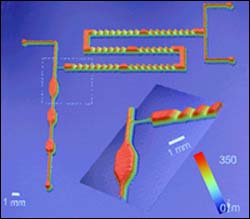New microfluidic device tackles tough synthesis tasks

NIST microfluidic device for synthesizing and analyzing polymers and other complex liquids.
A new type of microfluidic device that can help industry to optimize paints, coatings for microelectronics and specialty polymers has been developed by National Institute of Standards and Technology (NIST) researchers. The device is made of a chemically durable plastic that is resistant to many common organic solvents. It was fabricated with a rapid prototyping method also developed at the agency.
Described in the Aug. 18 issue of the Journal of the American Chemical Society,* such devices can be used to make specialty polymers in small amounts, or to rapidly change polymer ingredients so that the impact of expensive additives on material behavior can be systematically analyzed. This is becoming important as more specialty polymers use designer elements for applications in nanotechnology and biotechnology.
Devices typically measure about half the size of a credit card and are made with a technique called “frontal photopolymerization.” The NIST researchers adapted the technique to fabricating microfluidic devices. Ultraviolet light was shined through patterned “stencils” into a liquid layer of a chemical called thiolene. Areas exposed to the light harden into a solid polymer while unexposed areas remain liquid and can be flushed away, leaving relatively deep channels capable of handling thicker fluids than current lab-on-a-chip devices.
In a separate paper,** the NIST researchers provide detailed data about how varying doses of ultraviolet light affect the height of the polymer structures formed. Such data should be helpful for increasing the complexity of devices that can be fabricated with the technique.
Media Contact
All latest news from the category: Process Engineering
This special field revolves around processes for modifying material properties (milling, cooling), composition (filtration, distillation) and type (oxidation, hydration).
Valuable information is available on a broad range of technologies including material separation, laser processes, measuring techniques and robot engineering in addition to testing methods and coating and materials analysis processes.
Newest articles

High-energy-density aqueous battery based on halogen multi-electron transfer
Traditional non-aqueous lithium-ion batteries have a high energy density, but their safety is compromised due to the flammable organic electrolytes they utilize. Aqueous batteries use water as the solvent for…

First-ever combined heart pump and pig kidney transplant
…gives new hope to patient with terminal illness. Surgeons at NYU Langone Health performed the first-ever combined mechanical heart pump and gene-edited pig kidney transplant surgery in a 54-year-old woman…

Biophysics: Testing how well biomarkers work
LMU researchers have developed a method to determine how reliably target proteins can be labeled using super-resolution fluorescence microscopy. Modern microscopy techniques make it possible to examine the inner workings…





















